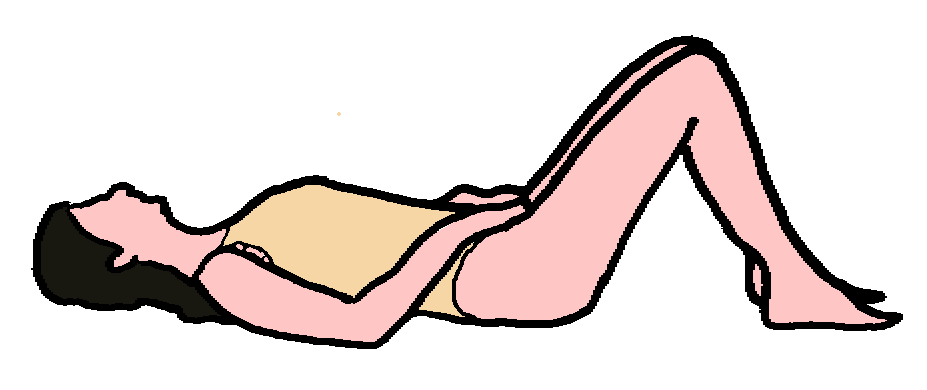|
|
|---|
Relaxation Script: Start
- Lie in the Relaxation Position (diagram).
- If needed, support your head with a folded up towel or bath mat, about 3 cm thick.
- Feet and knees in line with hips. Or wider if that is more comfortable.
- Place hands on abdomen.
Relaxation Script: Action
- Take a breath into your belly & feel it rise.
- On the next inbreathe, widen your throat like a wide bore vacuum cleaner and keep your breatbone still.
- (Breathing In): Raise your shoulders toward your ears.
- (Breathing out): Relax your shoulders away from your ears and feel your shoulder blades flatten to the floor like like dinner plates.
- (Breathing normally): Soften your breastbone.
- Feel your body widen, melt, and lengthen.
- Imagine sand trickling from your back pockets.
- Soften your breastbone and sides of chest and then take note of the line from the left collar bone to the side
of the neck - let it release! Do the same for the right!
- Pour olive oil between the base of your skull and the top of yor neck.
- Fatten the base of your tongue and feel it soften
- Scan the body as you breathe easy and continue to release tension.
- Tell yourself: "I am relaxed: from my toes....
to my tail bone... to the smile on my forehead.
(relaxation scripts, Scroll right>>>>....)
|
Relaxation Script: Position

What the Relaxation Script Does:
- Think of the relaxation as a drill for removing unproductive tension from the body
- once you've learnt it you can apply a shortened version prior to a performance, any time, any place.
- With relaxation comes awareness calmness and confidence and the possibility of change for the better
- both your movements, and your attitudes to yourself, your environment, and the people around you.
- Do it often so that your posture improves and you become a nicer person to be around!
Comment on Relaxation Techniques
A little tension (let's use the word "activation") is good when we are active but a lot is destructive.
Doing nothing seems a strange way to learn a new exercise program but the more we carry
relaxation into the workout the quicker we learn to do it skillfully and the most gain for the least effort.
Indeed you should apply a quick relaxation technique before and during each and every daily activity!
relaxation script, © Bruce Thomson EasyVigour Project
|
The Alexander Technique: "inhibiting".
"Inhibiting" is a specific relaxation script tailored to the needs of the "Alexander student".
It helps him (or her) to dis-associate a bad tension habit (potentially very destructive)
from a daily movement. The student pauses to apply general relaxation (similar to that outlined here)
and then (at "the moment of doing") goes on to do his prescribed "inhibiting script".
For example the stutterer first relaxes in a general way and then (just at the moment of
starting to speak) decides not to speak but rather, to pay attention to the inappropriate muscle tension
that builds up in his throat and neck whenever he intends to speak. Another example (easier to treat) would be
painful muscle tension in the forearm of a computer mouse operator.
Hannah somatics and release of chronic muscle contraction
Thomas Hannah taught that there are three basic patterns of reflex
muscle contraction which should only occur for short periods of time as
a response to either (1) noxious stimulus, or (2) the need to get something done quickly,
or (3) bodily injury that requires muscles to tense in order to splint the injured part.
He developed a mind body teaching method for identifiying when these muscle contraction reflexes become
chronic postural bad habits, and then for releasing them - see reference below.
Reference:
- The Official Body Control Pilates Manual Available from: http://www.bodycontrol.co.uk/
- FM Alexander: The Use of the Self; Orion Paper Backs, Reissued 2001 ISBN 0 75284 391 5
- Reflexes and the "cat stretch".
- John E. Sarno: Healing Back Pain : The Mind-Body Connection
- Search:
Relaxation Scripts
|
